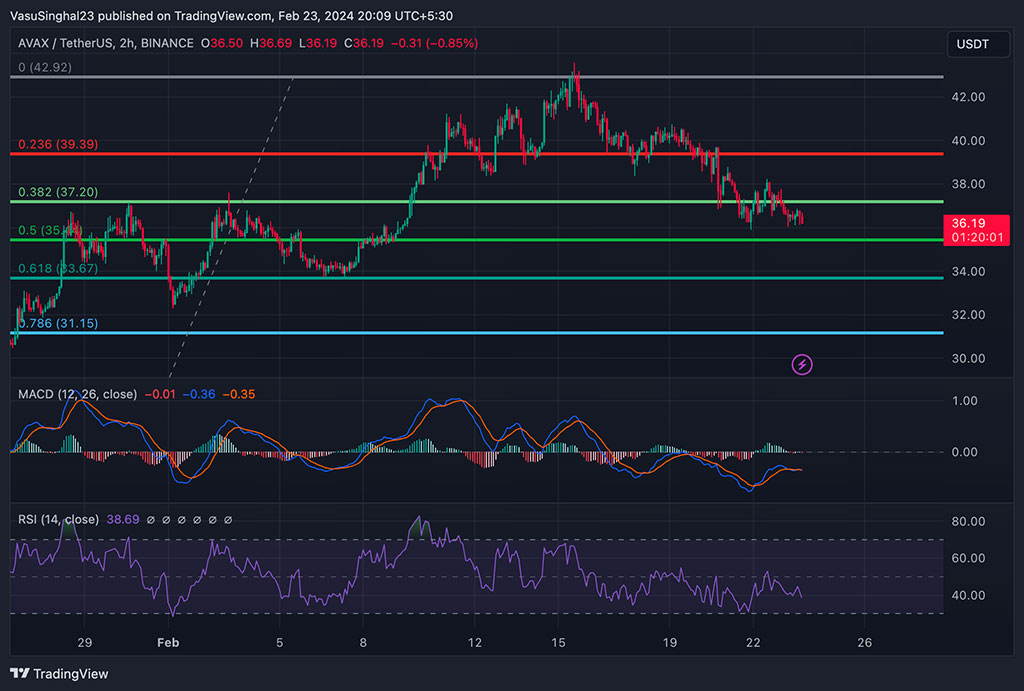The network’s native token AVAX saw a 3.7% drop in price following the outage, reflecting an immediate market reaction.
In a startling turn of events, the Avalanche blockchain experienced a significant outage, halting block production for nearly two hours and causing ripples in the crypto space.
Avalanche Blockchain’s Outage: What Actually Happened?
Early on February 23, 2024, the Avalanche blockchain, specifically its C-Chain, ceased to produce blocks, effectively freezing transactions and sparking concern among users and investors. The halt in block production lasted for almost two hours, a period during which the blockchain’s status page confirmed the absence of new blocks.
Investigating Avalanche primary network block production issue right now. Seems to be related to a new inscription wave launched about an hour ago.
— Kevin Sekniqi 🔺 (@kevinsekniqi) February 23, 2024
Kevin Sekniqi, co-founder of Ava Labs, initially attributed the problem to “a new inscription wave”. Inscriptions, which allow the recording of arbitrary data on the blockchain without smart contracts, have been identified as a potential factor in the stall in block finalization. This has prevented blocks from being accepted on the Primary Network, leading to a temporary but significant disruption.
Further investigation pointed to a “gossip-related mempool management bug” as the likely culprit. This code-related issue, unrelated to network performance or usage spikes, suggests a more complex underpinning problem that developers across the community are urgently addressing.
The Response and Market Reaction
The Avalanche development team, along with the broader community, sprang into action to diagnose and resolve the issue. Validator operators were in the process of upgrading their node software to version 1.11.0, part of the anticipated Durango upgrade, which aims to bring substantial improvements to the network. It remains unclear if the outage was directly linked to these upgrades or if it was a coincidental occurrence.
The network’s native token AVAX saw a 3.7% drop in price following the outage, reflecting an immediate market reaction. This incident draws parallels to a recent outage experienced by Solana, highlighting the vulnerabilities and challenges facing decentralized networks as they scale.
Avalanche (AVAX) Price Analysis

The chart depicts the price action of Avalanche (AVAX) in this month. The price level started on a positive note, breaking above the 0.382 FIB level. However, the selling pressure kicked in as soon as the price level crossed the $40 mark.
The chart also exhibits Fibonacci retracement levels suggesting potential support and resistance areas, with the price currently just above the critical 0.618 level at $36.67. This could be indicative of a possible support level.
The MACD indicator shows a bearish crossover, which may suggest a downward trend or decreasing momentum. Additionally, the RSI is under 40, which is below the neutral 50 mark, hinting at bearish momentum but not yet reaching the oversold region, which could imply a potential reversal if it were to dip below 30.
The price action is in a short-term decline and is struggling to maintain its stance above the significant Fibonacci support level. The indicators warrant a cautious approach as they suggest the possibility of a bearish phase. However, with the RSI not signaling an oversold condition, there may not yet be a strong indication of an imminent reversal.
In summary, the AVAX/USDT chart points towards a tentative bearish outlook with an emphasis on the $36.67 support level, which traders might be closely monitoring for potential buy or sell signals based on their strategies.





















